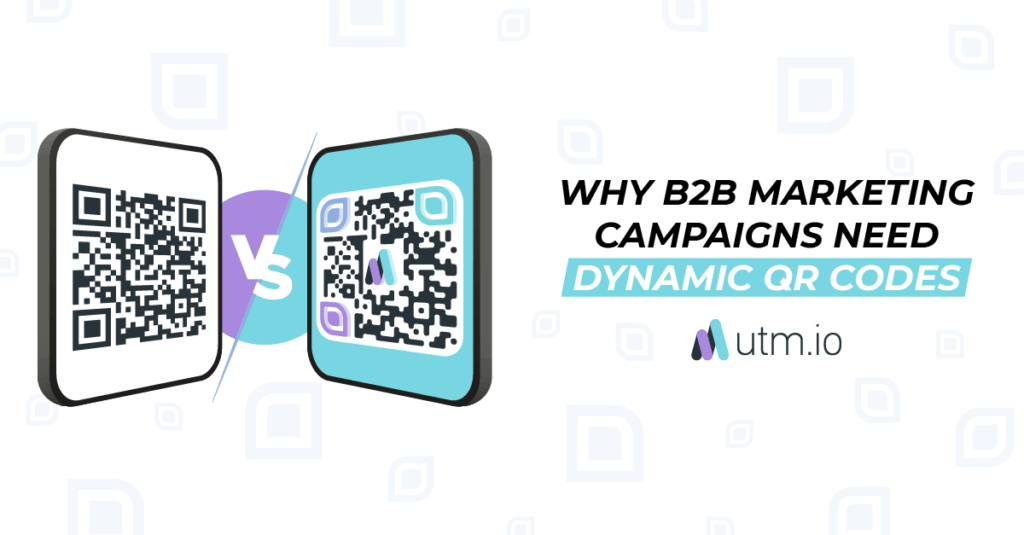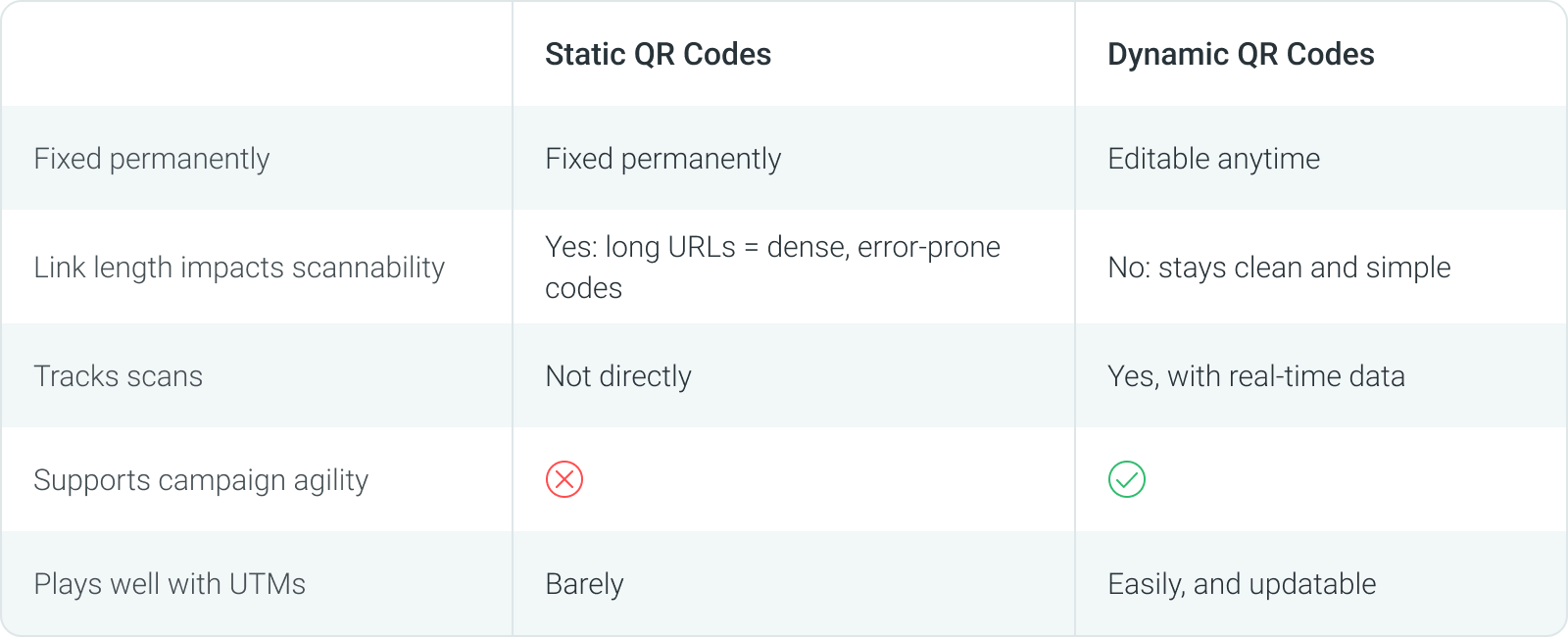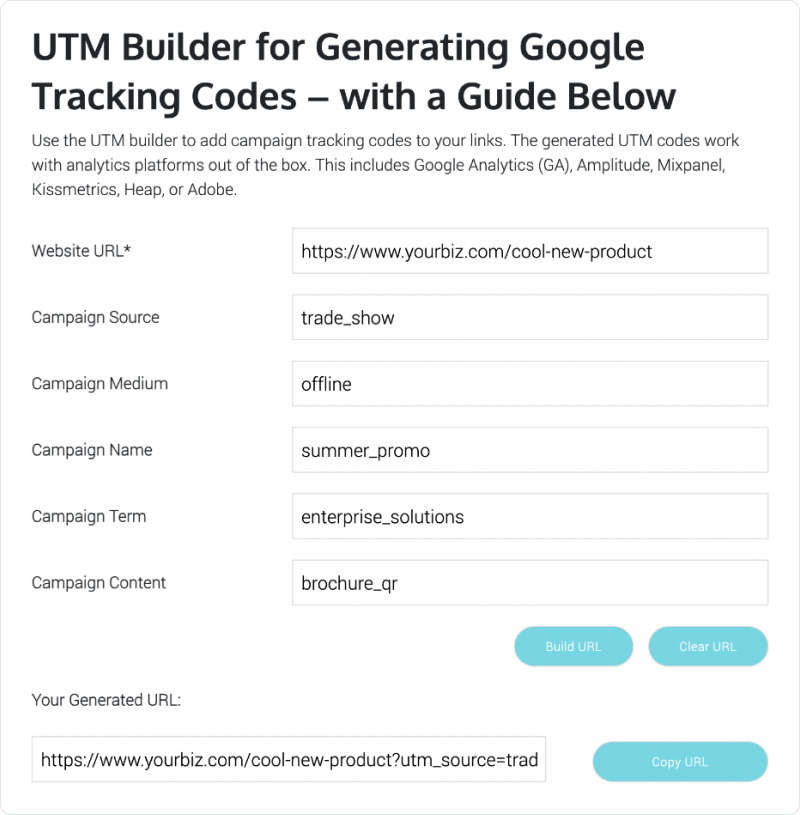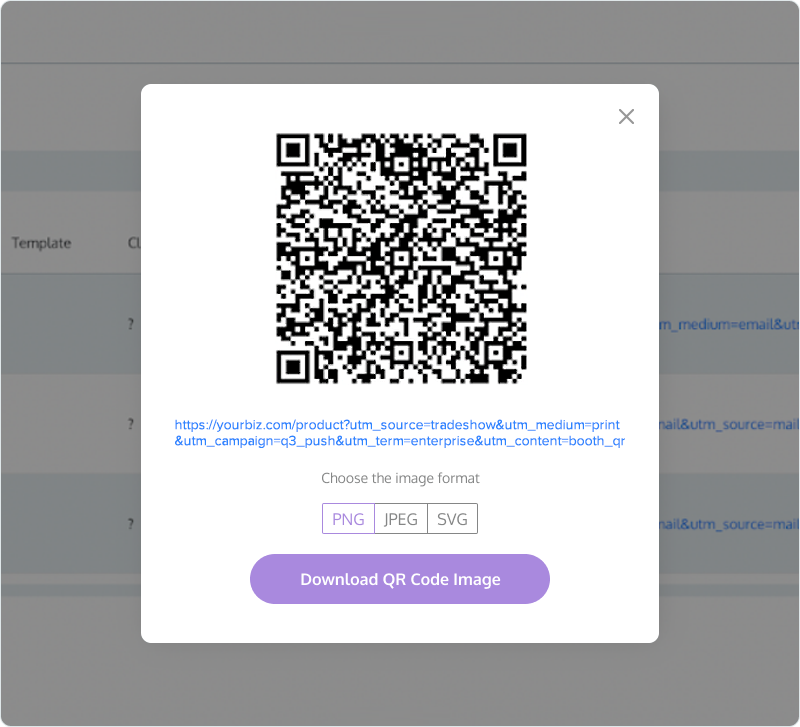QR codes are everywhere in B2B marketing, and for good reason. They’re one of the fastest ways to channel physical attention into digital action. Whether it’s on a booth banner, a printed brochure, or a follow-up mailer, a QR code lets someone jump straight to your content, form, or offer without having to remember a URL.
But most of the time, QR codes are used wrong. Or rather, marketers use the wrong QR codes.
Most marketers use static QR codes, which break with the slightest change, leading to outdated pages, broken links, and expired content.
Dynamic QR codes fix that. Paired with UTM tracking, they give you the flexibility to update where a code leads without reprinting anything, and without losing critical attribution and performance data along the way.
Here’s why they’re better for your budget, your buyers, and your bottom line.
A Brief History Lesson
QR codes were invented in 1994 by Japanese auto supplier Denso Wave to track parts in manufacturing. Unlike traditional barcodes, which store information in just one direction, QR codes are two-dimensional, meaning they can hold over 2,500 characters of data (compared to about 25 for a standard barcode).
In the decades since, they’ve been repurposed across industries. Today, they’re everywhere, from posters to packaging to in-person events. They can be scanned from across the street or off a fingertip-sized sticker. And they can lead just about anywhere.
But even with all that flexibility, there’s a hidden fragility in how most QR codes are used.
A Cautionary Tale
The first time I noticed this for myself, I was sitting in a restaurant. Like a lot of places, they’d swapped printed menus for QR codes on the tables. You’ve seen this.
I scanned the code…and got nothing. Not even a 404.
The domain hosting the menu was gone. The only way to fix it was to reprint every metal QR sign in the building, and they clearly hadn’t gotten around to it.
I still ate there. But it stuck with me: how many other QR codes out there are quietly breaking?
Now imagine that same scenario in B2B.
You’re not losing a $12 lunch. You’re losing a high-intent prospect because your link leads to a dead page, outdated content, or an offer that no longer exists.
Static vs. Dynamic QR Codes
That restaurant didn’t need new signage. They needed dynamic QR codes.
Here’s the difference:
With a static code, you’re stuck. Change your product page, update your pricing, shift your campaign, and suddenly your QR code points to the wrong place. Or nowhere at all.
With a dynamic code, you can change the destination behind the scenes, while the printed QR code stays the same.
That means fewer reprints, cleaner experiences, and better marketing outcomes. Especially when the URLs your QR codes point to include UTM parameters.
What does this look like in the real world?
Imagine printing your static QR code all over your conference materials, booth signage, business cards, you name it, and the day before the event, there’s a change to the URL or the UTM campaign.
Uh oh.
With a static QR code, you have no way to update what could be tens of thousands of dollars of field marketing materials.
Or you could have used dynamic QR codes instead.
How Dynamic QR Codes Work
Dynamic QR codes use a redirect.
Instead of pointing straight to your final URL, they point to a short link that you control. When someone scans the code, that short link instantly redirects them to the actual destination.
That redirect layer is the magic. It means you can:
- Update links at any time, even after printing
- Fix broken pages without replacing a single asset
- Change campaign targeting or UTMs on the fly
Here’s the basic flow:
Static QR:
QR code → Final URL (fixed)
Dynamic QR:
QR code → Short redirect URL → Final URL (editable)
It’s a simple tweak. But it makes your QR codes vastly more flexible, and far less likely to become liabilities over time.
Why Dynamic QR Codes are Better for Marketers
1. Update Links Without Reprinting
The giant benefit of dynamic QR codes is the ability to change the destination URL without touching the code even after it’s already printed, shipped, or shared.
That means you can:
- Update campaign URLs or offers based on performance
- Fix broken or outdated links in seconds
- Refresh CTAs or content without touching the code itself
- Keep evergreen assets relevant with new destinations
With a static QR code, any of those changes would mean reprinting everything. With a dynamic QR code, you just update the redirect.
2. Track Scans and Engagement in Real Time
Static QR codes can’t tell you much. Dynamic QR codes can.
You can:
- Track scans directly by time, device type, and location
- Sync scan data with GA4, Segment, CRMs, or CDPs
- Combine scan events with UTM data for full-funnel visibility
This means you can see not just who visits a page, but how they got there, when, and from where.
3. Personalize and Retarget More Effectively
Dynamic QR codes let you route different audiences to different experiences, even after distribution.
For example, you can:
- Swap out landing pages based on campaign performance or sales feedback
- Tailor messaging by industry, persona, or account
- Retarget visitors who scanned but didn’t convert
It also gives you more control when targeting accounts in an ABM program. If new stakeholders show up, you can adjust messaging without changing the physical code.
4. Keep Up With Timing and Context
Need to change your messaging mid-event? Update a link during a webinar? Shift campaign targeting after a big news event?
With a dynamic QR code, if your plans shift or a new opportunity emerges, you’re not stuck. You can:
- Adapt campaigns across channels instantly
- Run time-sensitive offers with precise control
- Keep printed materials useful even as strategy evolves
This kind of agility is almost impossible with static codes. With dynamic, it’s just another field to update.
5. Reduce Waste, Increase ROI
When QR codes fail, it creates friction. People drop off. Campaigns underperform. And marketing teams often don’t even know it happened.
Dynamic QR codes cut that risk and help ensure your print and field marketing efforts stay aligned with the rest of your funnel. The result is fewer wasted materials, better data, and more consistent performance across channels.
UTMs and URL Shortening
If you’re using QR codes in your marketing, UTMs should be part of the picture. They’re a standard way to feed campaign data into tools like Google Analytics, CRMs, CDPs, and other martech platforms.
There are five basic UTM parameters. Three are used in nearly every campaign:
- utm_source — the platform or channel (e.g. linkedin, brochure)
- utm_medium — the type of marketing (e.g. email, offline)
- utm_campaign — your campaign identifier (e.g. spring_launch, enterprise_promo)
Two others are optional, but often helpful:
- utm_content — for differentiating elements within a campaign (e.g. two different QR codes on the same flyer)
- utm_term — originally for paid search terms, but usable for any granular differentiator
Combined, these parameters help you understand what’s working and what’s not.
Why Shortening Matters
UTMs are great for tracking. But they also make URLs long. Sometimes very long.
In QR code world, that’s not ideal. Longer URLs = more complex QR codes, which:
- Are harder to scan from a distance
- Can break more easily if distorted
- Don’t always work well on low-end cameras
A URL like this:
https://yourbiz.com/product?utm_source=tradeshow&utm_medium=print&utm_campaign=q3_push&utm_term=enterprise&utm_content=booth_qr
…might generate a cluttered QR code that’s hard to read:
The Solution: Short Links and Dynamic Redirects
Dynamic QR code platforms like UTM.io let you generate a short redirect URL that handles all of this.
That short link is what gets turned into the QR code. It stays clean and easy to scan, no matter how many UTMs you attach to the final destination. And because it’s dynamic, you can still change the end URL any time you need to.
Bonus: If you use a branded domain for shortening, you can increase trust and boost click-through rates. Studies show branded short links see up to 39% more engagement than generic ones.
What You Can Do With Dynamic QR Codes
Dynamic QR codes aren’t just more flexible, they also open up new ways to engage, track, and convert across your offline and hybrid channels. Here are a few of the most effective use cases in B2B marketing:
Lead Generation at Events and Trade Shows
Events are a goldmine for intent-rich leads, but not everyone is ready for a hard pitch or a long conversation. QR codes let you meet people where they are.
Add them to:
- Booth banners and walls
- Printed collateral and swag
- Business cards, buttons, or stickers
Send visitors directly to gated content, lead capture forms, or follow-up materials, and update the link post-event to stay relevant. No reprinting required.
Interactive Marketing Collateral
You’ve spent time (and budget) producing whitepapers, ebooks, or case studies. Make them do more.
Drop in dynamic QR codes that:
- Point to the next step in the journey
- Route readers to a product demo or contact form
- Evolve over time to align with new campaigns
Even if someone downloads a PDF today and reads it three months from now, the QR code can still lead to the most relevant destination.
Account-Based Marketing (ABM)
When you’re targeting specific accounts, context matters.
Use dynamic QR codes to:
- Tailor landing pages by industry, role, or deal stage
- Track scan activity from physical mailers or custom gifts
- Pivot messaging based on new contacts or shifting priorities
You can even assign unique QR codes per account or vertical, then adapt the destination content mid-campaign without swapping out the assets.
Webinars and Online Events
Yes, even digital events can benefit from QR codes.
Use them in:
- Slide decks and presentation visuals
- Printed invites or reminders
- Follow-up materials and handouts
Direct attendees to registration, downloadable resources, or post-event recordings, then easily update the destination once the event is over.
Takeaways
QR codes are everywhere in B2B marketing, but static QR codes are brittle. They can’t adapt when your strategy, content, or offers change. And when they fail, they lead to broken links, outdated pages, missed opportunities.
Dynamic QR codes give you control and adaptability. You can update the destination anytime, pair each scan with campaign attribution, and build smarter, more resilient physical-to-digital experiences.
Used well, they’re not just a convenience. They’re a durable, trackable bridge between your offline efforts and your digital funnel.
Get great-looking, easy-to-scan dynamic QR codes
Learn more about how to build dynamic QR codes into your B2B marketing. Get in touch and we’ll show you how.



